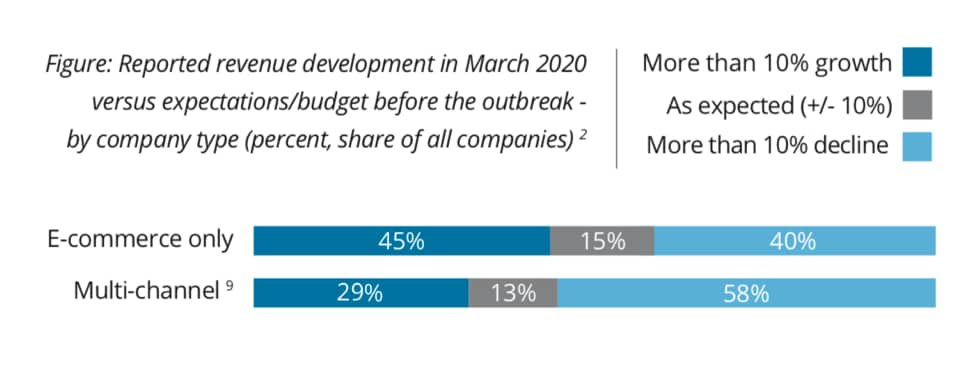Time is now to launch that digital market place, click-and-collect universe or acquire the critical digital talent you have been considering to ensure that your business is fit for fight post-pandemic.
The COVID-19 crisis is unlike anything the world has ever seen. While short-term orientation is key, it is becoming increasingly clear that the crisis will permanently shape the societal and economic order of the future, as has been the case with other historical crises.
Societal trends related to how we work, how we learn, how we shop, and how we use technology are changing rapidly. While these trends were already unfolding before the crisis, we are seeing an acceleration that will lead to a new normal coming out of the crisis. While a short-term reaction is needed to survive, a long-term view will make winners.
Data from the Danish E-commerce Association (FDIH) collected from its 600 members in the three weeks following the Danish lockdown confirm that consumer preferences are changing. Of the companies selling groceries, food and beverages, 65 percent have seen more than a 10 percent increase in revenues compared to what was expected. On the contrary, luxury goods and home furnishing are experiencing sweeping declines.
Source: FDIH: COVID-19 surveys with members during March 2020
What is even more interesting, however, than the sudden shifts in demand is that the success in certain categories has to a large extent been captured by the pure online companies. The survey shows that 45 percent are experiencing a growth of more than 10 percent versus expectations before the outbreak. Recent news of the online retailer nemlig.com hiring 400 new employees to cater for the increasing demand during the crisis underline this point. In the other end of the spectrum, multi-channel companies with physical footprint are challenged to protect their revenues despite temporary effects of consumer hoarding within certain categories. Examples include the large Danish retailers that may have seen an uplift in their online sales but not nearly enough to compensate for disappearing store traffic and struggling luxury and apparel categories.

Source: FDIH: COVID-19 surveys with members during March 2020
Practical recommendations to transition your business
Now is the time to act. The bold and ambitious companies that embrace the new reality and take timely action can capture market share and emerge after the crisis as market leaders. Action requires courage to reinvent your business model and invest in times of high uncertainty.
The following seven recommendations are critical to consider for CXOs and heads of e-commerce when responding to the new e-commerce reality:
- Explore digital business model: Revisit the foundation of your business model to make sure that it is still valid in the context of digital sales channels, profit models, and the services that you can provide your customers with. The time is now to create the digital market place, introduce the subscription model, or create the click-and-collect universe that you have been considering.
- Overinvest in digital marketing channels: Funnel your marketing spend toward the digital channels and media versus out-of-the-home platforms. Revisit both your paid and organic marketing (SEO) maturity. If you do not have the scale to invest competitively, find a suitable digital market place. Above all, strike appropriate marketing messages during and after the pandemic situation.
- Strengthen the customer experience: Understand the path to purchase of your (new) online customers and provide them with simple and human-centered UX design to create delightful shop- ping experiences across devices leveraging the latest technological innovation. If you have physical stores, ensure that they are experience-led and digitally connected with your e-commerce channel.
- Upgrade your supply chain and fulfillment: Making your supply chain customer-centric will for many businesses mean catering for a stronger product availability, fast last-mile delivery and easy returns, raising the question of flexible warehousing (perhaps utilizing your physical stores), logistics partnerships, and auto-replenishment models to manage profitability.
- Strengthen your technological platforms: Pressure test your e-commerce platform, expand necessary capacity limits to prepare for an increasing consumer flow, and take the opportunity to in- vest in advanced analytics capability to ensure personal, timely and automated customer interactions and recommendations across devices.
- Reinvigorate your organization: New digital talent (UX, visual design, scrum, etc.) will be needed, and many of your existing employees will not be able to adapt. Seize the opportunity to replenish your talent base, and invest ambitiously in your culture and digital ways of working leveraging latest corporate team and interaction platforms.
- CXO management attention: Elevate e-commerce to the executive agenda in your business to ensure adequate attention and priority. CEOs and managing directors should seize the opportunity to communicate clearly and strongly on the gravity of change needed for your company to emerge strongly post-pandemic.
Although the crisis-induced shifts in demand are temporary, it remains very likely that COVID-19 will permanently reshape e-commerce as we know it, separating winners from the rest. Companies that invest courageously and timely in pivoting their businesses toward the behavioral changes can capture market shares and emerge as market leaders post-pandemic.
